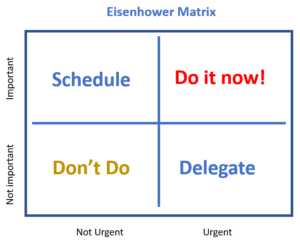Q: What are some practical tools, methods, mindsets, activities, etc., to improve an individual’s ability to plan, focus attention, manage multiple tasks, and regulate their behavior to achieve goals?
Improving executive function involves strengthening cognitive processes through practical tools, methods, activities, and mindsets that enhance focus, organization, emotional regulation, and decision-making. Here are some approaches:
1. Sleep and Physical Health
Prioritize Sleep: Ensure consistent, high-quality sleep to improve attention, memory, and problem-solving. Aim for 7-9 hours per night.
Exercise: Regular physical activity, especially aerobic exercises like walking or running, has been shown to improve cognitive flexibility, memory, and attention.
Nutrition: A balanced diet rich in whole grains, fruits, vegetables, and omega-3 fatty acids (like those found in fish) can support brain health and improve cognitive function.
2. Mindfulness and Meditation
Mindfulness meditation: Practicing mindfulness can enhance focus, emotional regulation, and the ability to stay calm under stress. Even short daily sessions can improve attention and inhibitory control.
Deep breathing exercises: Calming breathing techniques help manage stress and clear mental clutter, which aids decision-making and focus.
3. Structured Planning and Goal-Setting
To-do lists and checklists: Break larger tasks into smaller, manageable steps. Writing tasks down provides structure and reduces cognitive load, making it easier to prioritize and organize thoughts.
Time blocking: Allocate specific blocks of time for focused work on tasks. This method, popular in productivity systems like the Pomodoro Technique, helps maintain focus and avoid distractions.
SMART goals: Set Specific, Measurable, Achievable, Relevant, and Time-bound goals to maintain clarity and purpose, which supports long-term planning and focus.
4. Cognitive Exercises
Brain training apps: Apps like Lumosity, Peak, or Elevate offer cognitive games designed to improve memory, problem-solving, and flexibility in thinking.
Puzzles and strategy games: Activities like chess, Sudoku, crossword puzzles, or even strategic video games help improve cognitive flexibility, problem-solving, and working memory.
5. Organizational Tools
Digital productivity tools: Apps like Evernote, Trello, or Notion help organize tasks, projects, and notes. These tools allow for easy prioritization, reducing cognitive clutter.
Calendars and reminders: Use digital calendars and reminder apps to keep track of deadlines, appointments, and goals, reducing the burden on working memory.
6. Stress Management Techniques
Cognitive-behavioral strategies: Techniques like reframing negative thoughts or using positive self-talk can help manage stress and anxiety, improving emotional regulation and decision-making.
Breaks and downtime: Scheduling regular breaks and downtime for relaxation can refresh the brain, making it easier to stay focused during work.
7. Limit Distractions
Single-tasking: Focus on one task at a time, instead of multitasking, to improve attention and decision-making.
Declutter your environment: A clean and organized workspace reduces distractions and improves cognitive clarity.
Digital detox: Set boundaries on technology use, especially around social media or notifications, to reduce distractions and enhance focus.
8. Adopt a Growth Mindset
Embrace challenges: A mindset that views challenges as opportunities for growth can enhance cognitive flexibility and resilience.
Be patient with yourself: Accept that executive function improvement takes time and consistency. Treat setbacks as learning experiences rather than failures.
9. Work with Accountability
Accountability partners: Share goals with a colleague or friend who can hold you accountable for progress, which helps with motivation and follow-through.
Coaching or therapy: Executive coaching, cognitive-behavioral therapy (CBT), or counseling can provide personalized strategies to improve specific areas of executive function.
10. Journaling and Reflection
Daily reflections: Writing down thoughts, tasks, and experiences at the end of the day can help clarify priorities, improve emotional regulation, and enhance working memory.
Gratitude journaling: Focusing on positive aspects of your day can improve emotional well-being, which in turn strengthens executive function.
By regularly engaging in these tools, activities, and methods, you can significantly improve your executive function, helping you make better decisions, stay organized, and manage complex tasks more effectively.
Q: Let’s talk specifically about the question of having too many ideas in your head that inhibit focus. What are some practical methods to solve that?
When too many ideas are swirling in your head, it can be overwhelming and hinder focus, decision-making, and productivity. Here are some practical methods to address this issue and regain clarity:
1. Brain Dump
Write everything down: The brain dump technique involves quickly jotting down all the thoughts, ideas, and tasks that are occupying your mind. Once ideas are on paper, your brain is free from the cognitive load of holding them. Use a notebook, journal, or digital tool to list them.
No structure needed: Don’t worry about organizing your thoughts initially. The goal is to offload everything. Later, you can sort through the information.
2. Mind Mapping
Visualize connections: Create a mind map by writing a central idea in the middle of a page, then branching out related thoughts or tasks around it. This process helps organize ideas visually, showing how they relate to one another, which can make it easier to prioritize or group similar thoughts.
Clustering ideas: By clustering related ideas, you reduce the mental clutter and get a clearer picture of what’s important.
3. Prioritization Frameworks
 Eisenhower Matrix: Sort tasks or ideas into four quadrants based on urgency and importance. This can help clarify which thoughts need immediate action and which can be deferred, delegated, or eliminated altogether.
Eisenhower Matrix: Sort tasks or ideas into four quadrants based on urgency and importance. This can help clarify which thoughts need immediate action and which can be deferred, delegated, or eliminated altogether.
MoSCoW Method: Categorize ideas into Must have, Should have, Could have, and Won’t have right now. This helps you identify high-priority tasks and defer less critical ones.
4. Time Blocking for Idea Processing
Allocate time for thinking and decision-making: Instead of letting ideas constantly float in your mind, schedule specific blocks of time to think through your ideas. During this time, review your brain dump, mind map, or to-do list, and make decisions on which ideas are worth pursuing.
Separate planning from execution: If you’re overwhelmed by creative ideas, set time for brainstorming and other time for execution. This way, you can focus fully on one activity at a time.
5. Task and Idea Chunking
Break ideas into smaller tasks: If an idea feels too big, break it down into smaller actionable steps. This reduces the sense of overwhelm and makes it easier to tackle each component. Once you have bite-sized tasks, you can schedule or prioritize them more easily.
Focus on one step at a time: After chunking, focus on completing just one task or idea at a time, rather than trying to address everything at once.
6. Capture Tools
Digital note-taking apps: Use tools like Evernote, OneNote, or Notion to capture ideas quickly and organize them. These apps often allow tagging, categorizing, and prioritizing ideas, helping to organize mental clutter.
Voice memos: If writing down ideas feels slow or overwhelming, use voice memos to quickly record your thoughts. Review and organize them later.
7. Limit Input and Reduce Cognitive Load
Digital detox: Reduce the influx of new ideas by limiting time spent on social media, emails, or other sources of information. Too much input can prevent you from processing existing ideas.
Set boundaries for idea generation: Consciously limit the time you spend generating new ideas if you already feel overwhelmed. Instead, focus on developing and executing the ideas you already have.
8. Single-tasking
Focus on one idea at a time: Pick one idea to work on and give it your full attention. Resist the urge to multitask, as this divides your attention and makes it harder to make progress on any one thought.
Practice mindfulness: Mindfulness techniques, such as deep breathing or short meditation, can help calm a racing mind and increase focus on the present moment, making it easier to concentrate on one idea at a time.
9. Pomodoro Technique
Time-box your focus: The Pomodoro Technique involves setting a timer (e.g., 25 minutes) to work on a single task or idea without interruption, followed by a short break. This helps you maintain focus on one thing at a time and can alleviate the feeling of being overwhelmed by multiple thoughts.
10. Delegate or Let Go of Non-Essential Ideas
Delegate: If some ideas are actionable but not essential for you to handle, delegate them to others, especially if they are more suited to handle specific tasks or topics.
Let go: Not every idea needs to be pursued. Be comfortable with discarding ideas that don’t align with your priorities or that feel overwhelming. Sometimes letting go of less important thoughts clears space for the truly valuable ones.
11. Adopt a “Good Enough” Mindset
Avoid perfectionism: When managing too many ideas, perfectionism can add to mental clutter. Recognize that not every idea has to be perfect or fully developed. Aim for “good enough” on some tasks to free up mental space and focus on completing them.
12. Daily Review
Reflect and refine: At the end of each day, review your ideas and progress. This reflection can help you adjust priorities, discard outdated thoughts, and feel more in control of what’s on your mind.
Set tomorrow’s focus: Choose the top 1-3 ideas or tasks to focus on the following day. This can help you wake up with clarity and purpose.
These methods help reduce the cognitive burden of too many ideas and restore focus by organizing, prioritizing, and managing your thoughts more effectively.
Q: These are all good ideas, but it seems that they require discipline and personal motivation to get started. What if discipline and motivation are the problem? What are some techniques to improve there?
When discipline and motivation are the problem, it can feel difficult to even begin implementing strategies to manage overwhelming ideas or tasks. However, there are specific techniques designed to help boost discipline and motivation, even when they seem low:
1. Start Small: The 2-Minute Rule
Commit to a tiny action: If you’re struggling with discipline, start with just two minutes of work. The idea is to make the barrier to starting so low that it feels manageable. For example, write for two minutes, or organize for two minutes. Often, once you begin, you’ll find it easier to keep going beyond the two minutes.
Lower the expectations: Instead of expecting yourself to accomplish a big task, focus on simply starting. Completion isn’t the goal; action is.
2. Use the “5-Second Rule”
Act quickly: Developed by Mel Robbins, the 5-second rule involves counting down from 5 to 1 and then immediately taking action on what you need to do. This reduces overthinking and helps you act on instinct before hesitation sets in. It can be useful for tasks you’re avoiding, whether that’s getting out of bed or starting a project.
3. Build Habits through Consistency, Not Intensity
Focus on frequency, not effort: Instead of relying on motivation, build discipline by establishing consistent habits, even if they’re small. For example, if you want to write, start with just a few sentences each day. Over time, these small actions will become part of your routine, making discipline easier.
Atomic Habits: James Clear’s book “Atomic Habits” emphasizes breaking tasks down into tiny, manageable steps and attaching them to existing habits. For example, if you want to build discipline in working, attach a small task to something you already do daily, like reviewing your ideas after your morning coffee.
4. Gamification
Make tasks more engaging: Turn tasks into games by setting small rewards for completing certain actions. For example, give yourself points for every task you complete or time spent focused. Track your progress visually (e.g., with a habit-tracking app or chart), and reward yourself for meeting milestones.
Incorporate apps: Apps like Habitica, which turns your tasks into a role-playing game, or Streaks, which visually tracks your progress, can make building discipline more fun and motivational.
5. External Accountability
Accountability partners: Share your goals with a friend, colleague, or mentor who will check in on your progress. Knowing that someone else will follow up increases the likelihood that you’ll take action.
Join a group: Whether it’s an online community or a local group, surrounding yourself with people who share similar goals can provide motivation and encouragement. Working in parallel with others can make you feel more accountable.
Co-working sessions: Virtual or physical co-working sessions (like Focusmate) create structured time to work alongside someone else, which can help push you to take action.
6. Set Up “If-Then” Plans (Implementation Intentions)
Use specific triggers: Implementation intentions are a powerful way to bypass motivation. You set up clear “if-then” plans for when and where you’ll take action. For example, “If I have my morning coffee, then I will spend 5 minutes organizing my thoughts,” or “If it’s 3 PM, then I will review my to-do list.”
Make the cues specific: Tying actions to clear environmental or time cues reduces the need for motivation. The decision is already made in advance, making it easier to follow through when the time comes.
7. Limit Options and Choices
Reduce decision fatigue: Having too many choices can drain your mental energy and lead to procrastination. Simplify your environment by reducing the number of decisions you need to make. For example, pre-plan your day or pre-decide which tasks or ideas you’ll focus on.
Use pre-set routines: Create routines that you can follow without thinking, such as always working on a particular project first thing in the morning. Routines reduce the need for motivation by establishing automatic actions.
8. Remove Temptations and Distractions
Environment design: Set up your physical and digital spaces to encourage discipline. Remove distractions like your phone, close irrelevant tabs, or block social media during work hours using apps like Freedom or Cold Turkey. A cleaner environment helps reduce the temptation to procrastinate.
Automate self-control: Use tools that limit distractions for you. For instance, app-blockers, focus apps, or even scheduling specific times for non-essential tasks can help ensure you stick to the discipline without relying on willpower alone.
9. Use the “Temptation Bundling” Technique
Pair enjoyable activities with discipline-building tasks: If there’s something you enjoy, pair it with a task that requires discipline. For example, if you love listening to podcasts, only allow yourself to listen while you’re organizing your thoughts or working on a task. This creates a positive association with the less enjoyable task, increasing your motivation to do it.
10. Practice Self-Compassion
Be kind to yourself: If you struggle with motivation and discipline, avoid being overly critical. Studies show that self-compassion can actually boost motivation. Acknowledge that low motivation happens to everyone and focus on taking small, constructive actions without beating yourself up.
Progress over perfection: Instead of expecting perfection, celebrate small wins and progress. This can build momentum and make it easier to continue practicing discipline.
11. Break Tasks into Mini-Challenges
Use a challenge mindset: Turn tasks into mini-challenges with short time limits to spark your competitive spirit. For instance, challenge yourself to write 100 words in 10 minutes, or organize one part of your project in the next 5 minutes. This can shift your focus from the task itself to achieving small wins, boosting motivation.
12. Use Reward Systems
Set up immediate rewards: Create small, immediate rewards for completing tasks or sticking to your discipline routine. These can be simple pleasures like a favorite snack, a short break, or doing something fun once you complete a task. This helps train your brain to associate positive outcomes with disciplined behavior.
Larger milestones: For bigger goals, set larger rewards like a day off, a special treat, or something you’ve been wanting to do. This provides additional motivation to stick with your efforts.
By applying these techniques, you can cultivate discipline and motivation gradually, even when starting from a low point. Focus on taking small, manageable steps, reducing reliance on willpower, and leveraging external systems to support your efforts.
Q: This is all very good, but it’s a lot to tackle. Please break this down into the top five ideas, techniques, or practices that a person should start with if they have a hard time getting things done.
If you’re struggling to get things done, here are the top five techniques or practices to start with. These are simple, high-impact methods that can build momentum without requiring too much discipline or motivation upfront:
1. Start with the 2-Minute Rule
Commit to tiny actions: When faced with a task or idea that feels overwhelming, just commit to working on it for 2 minutes. Often, starting is the hardest part, and once you begin, it’s easier to keep going. This reduces the pressure to do a lot and helps you build momentum.
2. Brain Dump
Clear mental clutter: Take 5-10 minutes to write down everything on your mind—ideas, tasks, worries—without organizing or editing. The goal is to free up mental space by getting it all out of your head. Once it’s on paper, you’ll feel less overwhelmed and can begin to organize and prioritize more easily.
3. Use the “5-Second Rule”
Act quickly: When you feel resistance to starting something, count down from 5 to 1 and immediately take action. Whether it’s starting a task or getting out of bed, this method cuts through hesitation and helps you get moving before you can talk yourself out of it.
4. Time Blocking
Schedule focus time: Set aside specific blocks of time during your day to work on one task or idea. Even if it’s just 20-30 minutes, scheduling focus time helps reduce distractions and ensures you’re making progress. Stick to just one task during that block to build focus and reduce overwhelm.
5. Accountability Partner
Get external motivation: Share your goals with someone else—a friend, colleague, or mentor—and ask them to check in on your progress. Knowing that someone else is expecting an update can help you stay on track, especially when motivation is low. You can also set up co-working sessions with someone to work together, even virtually.
By focusing on these five techniques, you’ll reduce the mental burden of starting tasks, build momentum, and create a more structured environment for getting things done. Once these practices become part of your routine, it will be easier to tackle more advanced productivity strategies.




